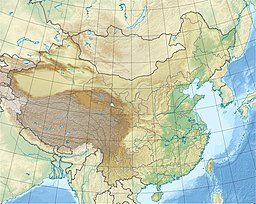Guanting Reservoir
| Guanting Reservoir | |
|---|---|
| Location | at the junction of Beijing and Hebei Province |
| Coordinates | 40°23′N 115°48′E / 40.383°N 115.800°E |
| Type | reservoir |
| Basin countries | China |
| Built | 13 May 1954 |
Guanting Reservoir (Chinese:
Guanting Reservoir is located at the junction of Beijing and Hebei Province,[5] mostly in Huailai County, Hebei Province, and a small part in Yanqing County, Beijing.[6] The reservoir is named after the dam built near the Guanting Town (
History
[edit]Guanting Reservoir started construction in October 1951[7] and was completed on 13 May 1954,[8] with the main flow of water being the Yongding River in Huailai. The reservoir covers an area of 230 square kilometers and has a total storage capacity of 2.2 billion cubic meters.[9]
Guanting Reservoir was a major source of fresh water for Beijing[10] and neighboring regions.[11] Due to water contamination, the reservoir was withdrawn from the system to supply Beijing with drinking water in 1997,[12] but after thorough treatment, the reservoir has been an alternate water source since 2007.[13]
References
[edit]- ^ Chinese Encyclopedia, Volume 49. Encyclopedia of China Publishing House. 1980.
- ^ Encyclopedia of National History of the People's Republic of China. Encyclopedia of China Publishing House. 1999. pp. 128–. ISBN 978-7-5000-6218-9.
- ^ "The Guanting Reservoir, the First Large-scale Reservoir since the Founding of the People's Republic of China, is Ready for Operation on May 13, 1954". State-owned Assets Supervision and Administration Commission. 13 May 2020.
- ^ Bryan Tilt (2 December 2014). Dams and Development in China: The Moral Economy of Water and Power. Columbia University Press. pp. 40–. ISBN 978-0-231-53826-8.
- ^ Meng, Jing; Zhou, Yunqiao; Liu, Sifan; Chen, Shuqin; Wang, Tieyu (14 December 2019). "Increasing perfluoroalkyl substances and ecological process from the Yongding Watershed to the Guanting Reservoir in the Olympic host cities, China". Environment International. 133 (Pt B): 105224. doi:10.1016/j.envint.2019.105224. PMID 31665680. S2CID 204965946.
- ^ "The water in the Guanting Reservoir is clearer". People's Daily. 19 June 2020.[permanent dead link]
- ^ "Resurrection of the Yongding River". Xinhuanet.com. 15 May 2020. Archived from the original on 16 May 2020.
- ^ "This Day, That Year: May 13". China Daily. 13 May 2019.
- ^ "The first large reservoir in New China was completed". State-owned Assets Supervision and Administration Commission. 15 May 2020.
- ^ "Large wetland park built in Winter Olympic host city". China Daily. 21 August 2017.
- ^ Yihui, Wen; Guihuan, Liu; Rui, Wu (1 July 2018). "Eco-Compensati on in Guanting Reservoir Watershed Based on Spatiotemporal Variations of Water Yield and Purification Services". Journal of Resources and Ecology. 9 (4): 416–425. doi:10.5814/j.issn.1674-764x.2018.04.009. S2CID 135005498.
- ^ "The "three accounts" of the Guanting Reservoir National Wetland Park". Qiushi. 27 October 2018.[permanent dead link]
- ^ "Guanting Reservoir is "alive"". Xinhua News Agency. 22 June 2020.


